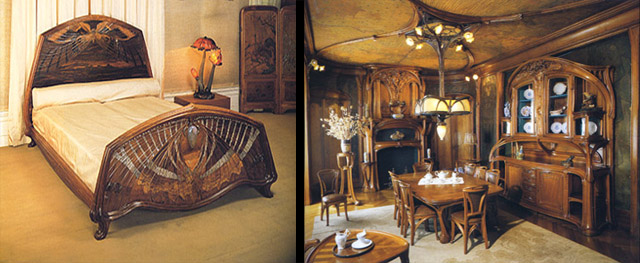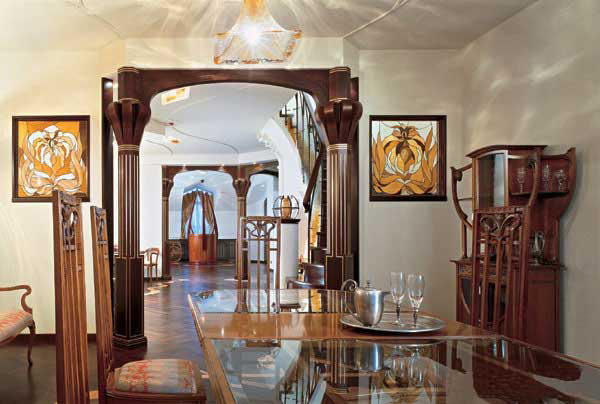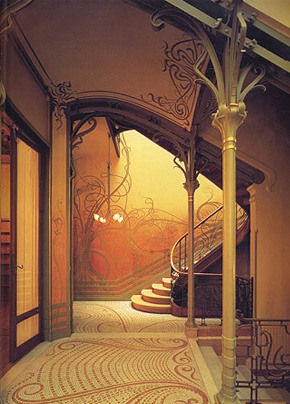| Art nouveau |
"Ar Nouveau"
Style of "Ar Nouveau"
The term of "Ar Nouveau" designate the elegant, multigenre style prospering from the beginning of 1880th years up to the First World War. Its birth has marked an approach of the century of great changes in art, when in life the century of cars has already strongly affirmed, and at full speed there was an industrial revolution.

The world promptly developed, however in the field of art these changes occurred much more slowly. Artists and designers opposed dominations of "historicism" when numerous style loans from cultures of the most different historical epoch mixed up in chock-full "Victorian" drawing rooms. Occurrence of influential middle class has led to growth of demand for graceful things. The machine century was capable to sate this demand with the mass production goods; however beauty duplicating has led to illegibility and bad taste.
In search of new decisions the historical periods were mercilessly maintained all without an exception, infinite returns to old styles were observed: classical, Gothic, Renaissance, baroque or to Louis ÕV style.
Unsatisfied with surrounding life and a situation in art when it was not necessary to speak about existence of a uniform direction any more, initiators of new movement put before themselves a problem of creation of the big style. Efforts of artists, architects and critics meaningly, purposefully formed new, not relying on samples of the past, style. The created style comprised quite distinct program of general esthetic transformations which can be presented as idea of creation fine.
New style has arisen almost simultaneously in many European countries and has received different names. More often terms were used "modernist style" (modern) and "Ar Nouveau" (in translation from French "l'art nouveau" literally "new art"). In France also were used terms "underground", "style of Gimara" - by name architect Hector Gimara, the author of unique design of inputs in the Parisian underground.
In Belgium new style also named "style of Orta", by the name of architect Victor Orta, whose mature works represent a bright illustration of classical variants of Ar nuvo. It's been also used the terms "style of 1900", "style of lines", "style of waves", "studio" and even such derisive names as "vermicelli", "eel", etc. In Germany this was "Jugendstil", in Italy - "flower style" or "Liberti", from the name of the London's department store of Arthur Liberti. In Austria was used the term "setsession", under the name of group Sezession created in 1897 in Vienna.

Refusal of straight lines and corners in favor of more natural smooth movement of the bent lines became stylistic feature of Ar of. Style originality of Ar nuvo was based on an ornamental sinuosity of lines of natural forms of a plant and animal life. Lines of Ar Nouveau often remind the dancing, wavy arabesques got by organic energy and vital force of plants.
Herman Obrista's well-known embroidery "scourge Blow" on a portiere of 1895 Originally work became the logo of a line of Ar nuvo was called "the Alpine violets" but when any critic has compared mad movements of a stalk of a plant to "furious bends of a falling scourge", the term "scourge blow" which soon became a firm stroke of style of Ar nuvo was born.
Another feature of new style has been an aspiration of architects and artists to create uniform synthetic style in, which all elements of architectural object, furniture of its interiors would be connected in a uniform art ensemble. Sources of the concept of esthetic synthesis - key concepts of new style - had William Morris (1834-1896), the English handicraftsman, the artist, the poet and a socialist. He has opened to the world art and philosophical treatises of critic John Reskina which, leaning against an esthetic principle of unity of Beauty and Good, asserted that the subject environment of a society testifies to its morale. The house of Morris together with friends-artists tried to transform into cumulative product of spatial arts, the harmonious environment, which will serve as a matrix of the ideal human relations, the way of life improved by art.
Life-building's experiment of Morrisa has repeated the master of a modernist style Henry Van de Velde, who has constructed a private residence of "Blumenverf", for whom it not only has designed all elements, from tableware to door handles, but also has developed sketches of clothes for all family.
The principle of art unity of all elements of the in detail-spatial environment gave to each project amazing integrity and art completeness. Ar Nouveau was not only new style - it was the new outlook synthesizing, all art forms and appreciating the handicraftsman and the architect also as high, as artist and the sculptor.
Source of ideas for artists of Ar Nouveau was a nature. The bud (a symbol of occurrence of new life) and exotic plants with long stalks and pale flowers became the most widespread theme. The preference was given to lilies, a water-lily, to irises and orchids. In the big fashion there were images of women with extremely long, streaming hair. Stylizations bright both graceful insects and birds - dragonflies and butterflies, peacocks and swallows perfectly gave in. Natural decorative effect of Ar Nouveau promoted its application in different genres.
In the highest popularity it was used for an ornament of almost each conceivable consumer goods of handwork and a mass edition, also facades of buildings and registration of interiors of many shops, restaurants and private residences.


To design examples in style of Ar Nouveau interiors and furniture of fantastic houses of the Spaniard Antonio Gaudi, registration of interiors in private residences of architect F.O.Shehtelja are bright interernye works of Belgians Victor Orta and Henry Van de Velde; lattices of the Parisian underground and Hector Gimara's furniture, interiors, lattices and furniture in Munich Avgusta Endelja, Berharda of the Pank eye; stained-glass windows is work Luis of Komforta Tiffani; products from glass and furniture of Ezhena of Halle, furniture of french designers-furnitures of Lui Mazhorelja, Victor Pruve, Ezhena Vallena, Jacque Grubera, etc.
On other principle built a search of the master "schools of Glasgow", headed by the Mackintosh and representatives of "Viennese Setsessiona". They created more reserved version of Ar Nouveau.
The style originality has brought in Ar nuvo, which the school of Glasgow, was characterized by pure geometry of forms in a combination with curvilinear superficial decorative elements. Buildings, interiors and the furniture, created under Charles Reni Makintosha's projects, in many respects have anticipated rectangular functionality of a modernism of 20th years.
Pure geometrical style of Glasgow has rendered crucial importance on development of Ar nuvo in Austria and Germany. A variant of Ar nuvo Viennese Setsessiona though still got mixed up on decorative effect of style, it was already ready to direct towards to the forgiven geometrical lines of a modernism. In a similar way Ar nuvo in Germany, where it is more known under the name of "jugen-stylel" (youth style), quickly dumped from itself(himself) fetters of 19 centuries and moved to a modernism. Masters of Viennese Setsessiona were Otto Wagner, Joseph Maria Olbrih, Joseph Hofman. In Germany was Peter Berens, Otto Ekman, Rihard Rimershmid.
The late modernist style everywhere tested accruing pressure of rationalistic tendencies and renewed gravitation to "eternal values" of the ordered form. Vasily Kandinsky's book "Concerning spirituality of art" (1911) became truly the program document of the early modernism calling for rupture with a heritage of the past, to rupture with the nature, to an exception of art of all natural. A late modernist style a transitive stage to new style directions of the beginning of 20 centuries - art deko, to a functionalism, on which basis of the philosophy formation modern design, in turn, has grown.





